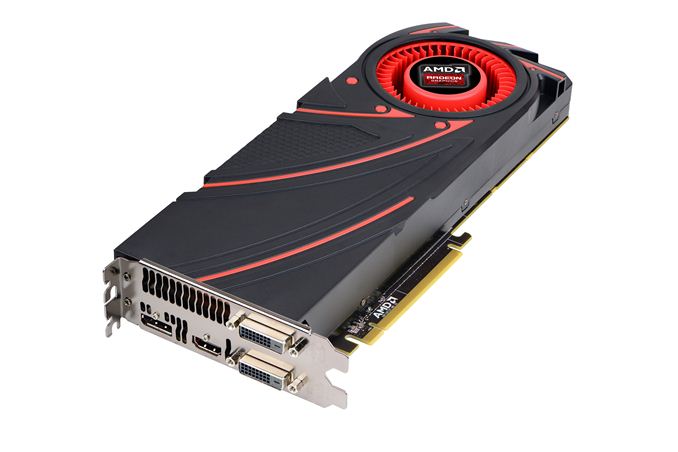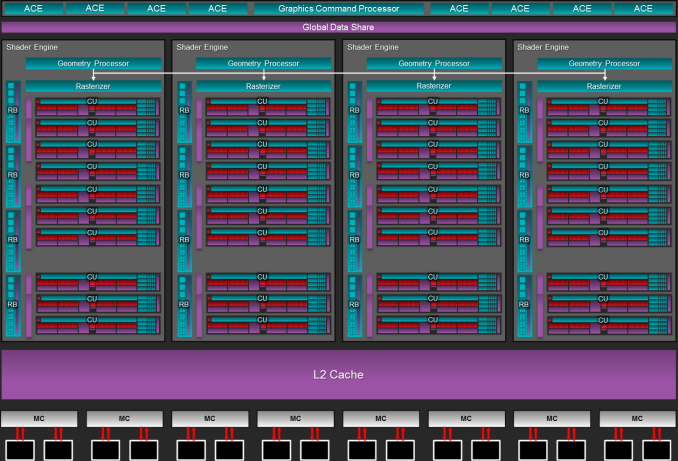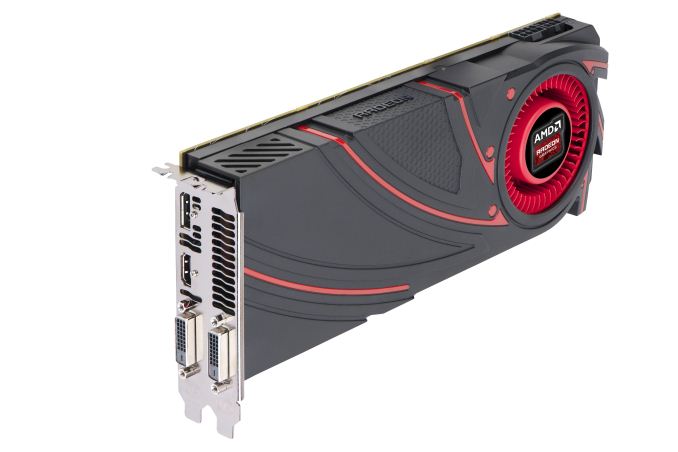The AMD Radeon R9 290 Review
by Ryan Smith on November 5, 2013 12:01 AM EST- Posted in
- GPUs
- AMD
- Radeon
- Hawaii
- Radeon 200

With the launch of AMD’s Radeon R9 290X less than 2 weeks ago, the video card marketplace has become very active very quickly. The 290X not only reasserted AMD’s right to fight for the video card performance crown, but in doing so it has triggered an avalanche of pricing and positioning changes that have affected both NVIDIA and AMD.
NVIDIA for their part cut the price of the GTX 780 and GTX 770 to $500 and $330 respectively, repositioning the cards and giving them their first official price cuts since their spring launches. Meanwhile AMD has also made some changes, and although 290X is unaffected for the moment, 290 was affected before it even launched, receiving an arguably significant specification adjustment. Consequently with GTX 780’s price cut being NVIDIA’s counter to 290X, 290 has gone from just being a lower tier Hawaii card to also being AMD’s counter-counter, and in the process has become a somewhat different card than what it was going to be just one week ago.
But before we get ahead of ourselves, let’s start at the beginning. With the successful launch of the 290X behind them, and the equally successful launch of their new flagship GPU Hawaii, AMD is ready to make their next move. Launching today will be the Radeon R9 290, the obligatory lower-tier part for AMD’s new flagship lineup. Making the usual tradeoffs for a lower-tier part, AMD is cutting down on both the number of functional units and the clockspeeds, the typical methods for die harvesting, in exchange for a lower price. Now officially AMD has not announced the Radeon R9 290 in advance, but with listings for it having already gone up on the same day as the 290X, it’s something that everyone has been expecting.
As always we’ll offer a full breakdown of performance and other attributes in the following pages, but before we even begin with that we want to point out that the 290 is going to be one of AMD’s most controversial and/or hotly debated launches in at least a couple of years. The merits of 290X were already hotly debated in some gaming circles for its noise relative to its performance and competition, and unfortunately 290 is going to be significantly worse in that respect. We’ll have a full rundown in the following pages, but in a nutshell AMD has thrown caution into the wind in the name of maximizing performance.
| AMD GPU Specification Comparison | ||||||
| AMD Radeon R9 290X | AMD Radeon R9 290 | AMD Radeon R9 280X | AMD Radeon HD 7970 | |||
| Stream Processors | 2816 | 2560 | 2048 | 2048 | ||
| Texture Units | 176 | 160 | 128 | 128 | ||
| ROPs | 64 | 64 | 32 | 32 | ||
| Core Clock | 727MHz | 662MHz | 850MHz | 925MHz | ||
| Boost Clock | 1000MHz | 947MHz | 1000MHz | N/A | ||
| Memory Clock | 5GHz GDDR5 | 5GHz GDDR5 | 6GHz GDDR5 | 5.5GHz GDDR5 | ||
| Memory Bus Width | 512-bit | 512-bit | 384-bit | 384-bit | ||
| VRAM | 4GB | 4GB | 3GB | 3GB | ||
| FP64 | 1/8 | 1/8 | 1/4 | 1/4 | ||
| TrueAudio | Y | Y | N | N | ||
| Transistor Count | 6.2B | 6.2B | 4.31B | 4.31B | ||
| Typical Board Power | ~300W (Unofficial) | ~300W (Unofficial) | 250W | 250W | ||
| Manufacturing Process | TSMC 28nm | TSMC 28nm | TSMC 28nm | TSMC 28nm | ||
| Architecture | GCN 1.1 | GCN 1.1 | GCN 1.0 | GCN 1.0 | ||
| GPU | Hawaii | Hawaii | Tahiti | Tahiti | ||
| Launch Date | 10/24/13 | 11/05/13 | 10/11/13 | 12/28/11 | ||
| Launch Price | $549 | $399 | $299 | $549 | ||
Diving right into the hardware specifications, Radeon R9 290 is a bit more powerful than usual for a lower-tier part. AMD has cut the number of CUs from 44 to 40 – disabling 1 CU per SE – while adjusting down the base GPU clockspeed and boost GPU clockspeed to from 727MHz and 1000MHz to 662MHz and 947MHz respectively. However AMD has not cut the amount of memory, the memory clockspeed, the memory bus width, or the number of ROPs, leaving those at 5GHz for the memory clockspeed, 512-bits for the memory bus width, and all 64 ROPs for the back-end hardware.
As a result the differences between the 290 and 290X are on paper limited entirely to the clockspeed differences and the reduced number of CUs. At their top boost bins this gives 290 95% the clockspeed of 290X, and 91% of the shader hardware, giving 290 100% of 290X’s memory performance, 95% of 290X’s ROP and geometry performance, and 86% of 290X’s shading/texturing performance.
Compared to AMD’s last generation offerings, the 290 is going to be closer to 290X than 7950 was to 7970. 290 retains a larger percentage of 290X’s shader and ROP performance, never mind the fact that the full 320GB/sec of memory bandwidth is being retained. As such despite the wider price difference this time around, performance on paper is going to be notably closer. Paper will of course be the key word here, as in the case of 290 more so than any other card we’ve looked at in recent history theory and practice will not line up. Compared to the 290X, practice will be favoring the 290 by far.
Moving on to power consumption, perhaps because of AMD’s more aggressive specifications for their lower-tier card this time around, power consumption is not dropping at all. AMD is still not throwing us any useful hard numbers, but based on our performance data we estimate the 290 to have a nearly identical TDP to the 290X, leading us to keep it at an unofficial 300W. Lower-tier parts typically trade performance for power consumption, but that will not be the case here. Power consumption will be identical while performance will be down, so efficiency will be slipping and 290 will have all the same power/cooling requirements as 290X.
Meanwhile like the 290X launch, the 290 launch is going to be a hard launch, and a full reference launch at that. As such we’ll be seeing 290 cards go up for sale at the usual retailers today, with all of those cards using AMD’s reference cooler and reference board, itself unchanged from the 290X.
As for pricing and competitive positioning, AMD will be launching the 290 at what we consider to be a very aggressive price of $399. Based on the initial specifications, the performance, and the competition, we had been expecting AMD to launch this at $449, mirroring the launch of the 7950 in the process. But AMD has gone one step further by significantly undercutting both themselves and NVIDIA.
290’s immediate competition on the AMD side will be the $549 290X above it and the $299 280X below it, while on the NVIDIA side the competition will be the $499 GTX 780 above it and the $329 GTX 770 below it. Pricing wise this puts 290 as closer competition to 280X/GTX 770 than it does the high-tier cards, but as we’ll see in our benchmarks AMD is aiming for the top with regards to performance, which will make price/performance comparisons both interesting and frustrating at the same time.
NVIDIA for their part will have their 3 game Holiday GeForce Bundle on the GTX 780 and GTX 770, presenting the same wildcard factor for overall value that we saw with the 290X launch. As always, the value of bundles are ultimately up to the buyer, especially in this case since we’re looking at a rather significant $100 price gap between the 290 and the GTX 780.
| Fall 2013 GPU Pricing Comparison | |||||
| AMD | Price | NVIDIA | |||
| Radeon R9 290X | $550 | ||||
| $500 | GeForce GTX 780 | ||||
| Radeon R9 290 | $400 | ||||
| $330 | GeForce GTX 770 | ||||
| Radeon R9 280X | $300 | ||||
| $250 | GeForce GTX 760 | ||||
| Radeon R9 270X | $200 | ||||
| $180 | GeForce GTX 660 | ||||
| $150 | GeForce GTX 650 Ti Boost | ||||
| Radeon R7 260X | $140 | ||||












295 Comments
View All Comments
swing848 - Tuesday, November 5, 2013 - link
It will only get loud for me when playing games or the occasional benchmark. During games I weara headset, and during benchmarks I can leave the room. I have a room dedicated to computer use
and the house has good sound proofing, so, it will not bother other people.
If I want it quiet I will use a water cooler with a large radiator and fan, my Cooler Master HAF
922 case already has sealed holes for tubing for an external radiator.
Water cooling is better than dumping all the hot air from the video card into my case, even if it
is well cooled with 200mm fans. I overclock my CPU and I do not want it, RAM, or chips on the
motherboard to get any hotter than necessary.
The only thing I will miss on this card are Black Diamond Chokes and Digital Power 8+2+2 phase
used on the Sapphire R9 280X Toxic [Black Diamond Chokes are also used on Sapphire R9 280 Vapor-
X]. To be honest I do not know how many mosfits are dedicated to cool GPU functions on the R9
290. In any event, both the Toxic and Vapor-X dump hot air into the case.
Another thing I would like to have seen on the Sapphire R9 290 is a metal back plate.
somethingwicked - Tuesday, November 5, 2013 - link
what the holy gee whizthe new AMD drivers are insane! 290x is speeding past Titan now and 780 is a turtle while 290x is a ferrari... the new 290 is performing like the 290x was at launch and now the 290x is a card unto its self at the top of the food chain
thank goodness for competition
i smell more deep nvidia price cuts cause AMD is kicking butt
TheJian - Tuesday, November 5, 2013 - link
rofl. So NV just has to release a "fan that drives you out of the room" driver now to respond. IF NV did this all of you would be falling all over yourselves to moan and groan claiming NV was cheating. AMD does it, and wow this is awesome, I love the noise anyway...LOL. Technically this is all NV has to do though right? Raise the fan speed until it hits another 10DB's and blow them down again.Perf is great, but not if it drives me out of my room. There is nothing stopping NV from adding 10DB's to their cards and calling it a day. But I don't want this being called normal. IMHO this is a crap way to get perf and a game both sides can play. If NV does this tomorrow and says we're hiking prices because if we overclock our cards also (which is essentially what they're doing here, just reverse, raise fan so clocks boost higher, same story) we blow AMD away.
https://www.youtube.com/watch?v=djvZaHHU4I8
Both cards clocked to max (290x vx. 780, NOT TI mind you).
Fast forward to 8:40 for benchmarks...AMD is blown away. The 780 didn't lose ANY game. Not one. And in star citizen blows AMD away. I don't believe these cards will be used mostly on 1600P or 1440p either. 1080/1200p is running on 98.5% of our screens and a large portion of the 1.5% that is above these two resolutions are running TWO or more cards. Steam's surveys don't lie. Already they turn down nearly every game at 1440p here which to me means you won't run there anyway (they are not reporting mins here for most games). Everything is pretty maxed in linustechtips vid above at 1080p, and you should be able to stay above 30fps (probably?) doing it. They are reporting avg's here at anandtech and already turning stuff down. Meaning maxing graphics on a lot of games would be unplayable under 30fps especially when lots of crap is going on. LOW DETAIL? Seriously? So Ryan is assuming you'll buy one of these cards (or any single gpu card) to then go out and buy a 1440p monitor (which are still over $550 for any brand you'd recognize the name of on newegg, and start there when you choose NEWEGG ONLY) and then run the details on low to play games? I don't think so. If he's assuming we're all going to buy new monitors, might as well get Gsync instead (though I'd say wait for more models first even if Asus has a decent one out of the gate). Heck some of the games have details DOWN on 1080p here (total war2, medium shadows? still looks like it would hit below 30fps on most cards).
For anyone saying get a water block...LOL. How much did my card cost if I have to add that and how many regular users even know what water is or are even capable of adding one? I say that as a guy who has as Koolance kit. Or even adding an aftermarket fan. Isn't this upping the cost of the card then?
Both solutions are unacceptable and attempting to fix a problem caused by shipping a card that already is unacceptably NOISY, hot and sucking up watts vs. it's competition. No games either.
Add on top reviews elsewhere show other games that give an opposite story. Techpowerup, Techspot, Guru3d, Hardocp show wins for AC3, COD Blackops2, Diablo3 (spanked by NV), FarCry3, SplinterCell Blacklist, Star Craft2 (spanked, heck 770 does well), World of Warcraft (spanked), Skyrim (lost 3 resolutions, 290/x won 1600p, oddly lost upping to 5760), Resident Evil 6.
So maybe you need to take a bit of a WIDER view than anandtech ;) I don't call 53 more watts than 780 (or 70 more than 770) a victory. Never mind the noise it creates while doing it. Is running 10DB's higher really a better card? Do people here realize that noise in DB's is EXPONENTIAL? A 10Db noise difference is HUGE (ryan did say 2x as loud). 12 degress hotter for this kind of perf isn't good either. I see a clear reason NV should be charging more than AMD's cards. They are better. I can OC and beat them easily without all the noise, heat, watts. I don't need a waterblock to do this either...ROFL. Whatever I already have on my card can do this easily and come in UNDER Ryan's 7970 noise levels that he calls acceptable.
I see no price cuts, but probably a few more videos poking fun at AMD like this:
https://www.youtube.com/watch?v=oV5vs27wnCA
Tell me that isn't funny ;) I'm wondering if someone at NV paid for this vid to be made...LOL. Sparks, dripping fire, ROFL. Great job of getting the message across.
rviswas11 - Tuesday, November 5, 2013 - link
i couldn't give two s***ts because when i game i wear noise cancelling headphones that i use for listening to music on the busrviswas11 - Tuesday, November 5, 2013 - link
so i'm happy. and with the exception of skyrim i could set the graphics card to 10% fan profile and max the game. i run quite afew mods for skyrim don't play it anymore.but i can see how the noise can be a major issue for a lot of people.
Morawka - Tuesday, November 5, 2013 - link
your not understanding. At this level of noise, not even noise canceling headphones will drown it out. This is louder than a 747 jet from 100 meters away.mgl888 - Tuesday, November 5, 2013 - link
You'd better be trolling.60dB is the intensity of a normal conversation.
Galidou - Tuesday, November 5, 2013 - link
Comon, a 747 jet 100 meters away... you gotta be freaking stupid to only think it could be true :Oahlan - Saturday, November 9, 2013 - link
@GalidouWhat do expect from nvidia fantards who think higher price is better.
They are so unsecure and delusional that they comment in every AMD review...
Nvidia is loving their stupidness...
1Angelreloaded - Saturday, November 16, 2013 - link
120 decibels is a 747 I would know I work around them, But AMDs new cards are crap, 550$ to add a water cooling system totaling around 200-300$.......either way its not a deal really, Nvidia cards have more headroom on air and water, while AMD's cards are impressive to an extent Hawaii is a bastard step child of sorts, it is probably a failed version of the next chip to compete with Maxwell but had no choice but to release it.